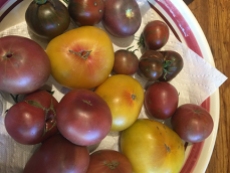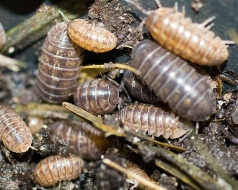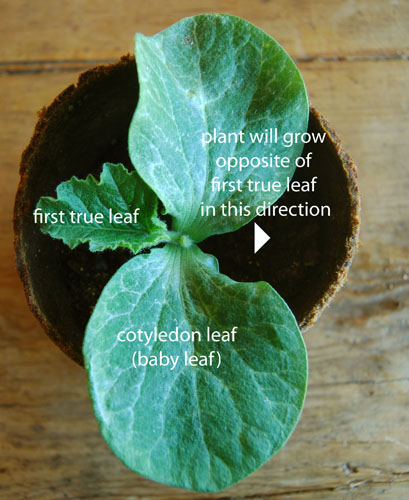
Sungold tomatoes
Here are my favorite vegetables that I grew for 2017. Mind you I’m super picky and I’m sure there are many other varieties out there waiting to be tried that are great. That’s what keeps it interesting for me. Also I give you where I bought the seeds or transplants. You may be able to buy these elsewhere but this is where I purchased them from.
2017 Tomato Winners
***ALL-TIME FAVORITE TOMATO
Lucky Cross: MY FAVORITE TOMATO-Bigger tomato. Starts yellow then turns more pinkish yellow on the outside with red marbling inside. Sweet and luscious with few cracks. Ripens later in the season but before the end of the season. Part Brandywine and tastes like them. DELICIOUS! Not to be confused with Little Lucky tomato. Seeds from Victory Seeds
RED
Goliath: A very abundant and nice size red tomato. No cracks and old-fashioned tomato flavor-excellent. Seeds from Totally Tomato seeds
Costoluto Genevese: Beautiful fluted tomato with old-fashioned tomato flavor from Italy. Seeds from Baker Creek Heirloom Seeds
Marmande Garnier Rouge: A medium to large dark-red slightly fluted tomato from France-excellent old-fashion tomato flavor. Seeds from Secret Seeds Cartel
Big Zac: Huge, red sweet tomato-takes all season to ripen but still one of my favorites-worth the wait. Transplants from Agua Fria Nursery here in Santa Fe
PASTE
Goldman’s Italian American: My favorite for a sauce tomato-Unique, beautiful and large tomatoes have a pear shape, being ribbed and pleated. These have an intense red color and fantastic flavor when ripe. Thick, red flesh is perfect for delicious tomato sauces. Ripens towards end of season. Seeds from Baker Creek Heirloom Seeds
PINK
NEW! Stump of the World: Big pink tomato with sweet flavor. Good at high altitudes. Seeds from Tomato Growers
PURPLE or BLACK
Purple Cherokee: Dusky purple with dark shoulders-Always a favorite-sweet, flavor. Seeds from Seed Savers Exchange or transplants from Agua Fria Nursery here in Santa Fe
Paul Robeson: Dark brown with green shoulders-Always a favorite-sweet, earth flavor. Seeds from Seed Savers Exchange or transplants from Agua Fria Nursery here in Santa Fe
BI-COLOR
Pink Berkeley Tie Dye: Dark pink with green stripes-great sweet flavor.
Seeds from Wild Boars Farms or transplants from Agua Fria Nursery here in Santa Fe
Black and Brown Boar: Brownish-red tomato with green stripes-good, sweet, earthy flavor. Seeds from Wild Boars Farms
NEW! Summer of Love: Large and very meaty red/yellow bi-color beefsteak with purple anthocyanin splashes on the sun-kissed fruit-wonderful flavor. Seeds from Wild Boars Farms
NEW! Lover’s Lunch: A very beautiful and tasty striped red/yellow with bi-colored flesh. This large, meaty, fruity and sweet tomato has stand-out flavor. Seeds from Wild Boars Farms
NEW! Lucid Gem: First they ripen yellow, than more of an orange when very ripe. Very attractive with black purple anthocynin splashes on shoulder that contrast with the yellow skin. Flavor is very good- Sweet with fruity tones. Very meaty, very few Seeds – One of the best varieties for heat tolerance. Seeds from Wild Boars Farms
NEW! Solar Flare-XL: Bigger than the regular Solar Flare-very sweet red with faint yellow stripes. Seeds from Wild Boars Farms
CHERRY TOMATOES
Artisan Blush Tiger: I love this one-fruity flavor. Seeds from Johnny’s Seeds or transplants from Agua Fria Nursery here in Santa Fe
Pink Bumblebee: Great sweet flavor. Seeds from Johnny’s Seeds or transplants from Agua Fria Nursery here in Santa Fe
Black Cherry: One of my favorites that I grow EVERY year. Seeds from Seed Savers Exchange or transplants from Agua Fria Nursery here in Santa Fe
Sungold: One of my few hybrids-Always a favorite-super sweet yellow cherry tomato. Transplants from Agua Fria Nursery here in Santa Fe
——————————————————————————————–
2017 vegetable winners
ARUGULA
Wasabi arugula: This arugula gives the same nose-tingling sensation as the wasabi condiment used in Japanese dishes. This variety is very quick to bolt but delicious. Grow in early spring before heat. Seeds from Johnny’s Seeds or transplants from Agua Fria Nursery here in Santa Fe
BEANS-DRY
NEW! Borlotti ‘Lamon’ beans: Climbing beautiful cream, red splashed shell on outside with beans being a pale pink with red splotches inside if you let them dry. I like to harvest them when dry. According to the Venetians, Lamon’s are “THE” bean for ‘pasta fagiolo’. Seeds from Seeds of Italy
BEANS-GREEN
Émérite Filet Pole Bean: Émérite is a true Filet Bean from France, produced on graceful vines growing to 8′ tall. When picked early and often, the beans are tender and have outstanding flavor. Seeds from John Scheepers Kitchen Garden Seeds
BEETS
Craupadine: I’ve tried this one before-poor germination every year except for one year and the one year it did germinate, it tasted FANTASTIC-sweetish beet I’ve ever eaten. Will try to start seeds inside this year to see if I get better germination. Would really like to get this one again. Seeds from Baker Creek Heirloom Seeds
BOK CHOY
Violetta bok choy: A beautiful green with purple tipped leaves and tastes great sautéed. Transplants from Agua Fria Nursery here in Santa Fe
CABBAGE
Kalibos Red cabbage: This Eastern European heirloom cabbage has a pointed shape and intense red/purple leaves. Beautiful and sweet flavor. Seeds from Seed Savers Exchange
CHARD
Argentata chard: Has green leaf with big white stalks that when cooked, melt in your mouth. Plus it is the most cold tolerant variety in my garden outlasting many other varieties of chard. Seeds from John Scheepers Kitchen Garden Seeds
CUCUMBERS
Poona Kheera: My all-time favorite eating cucumber. Seeds from Baker Creek Heirloom Seeds
EGGPLANT
Fairy Tale: my favorite-never bitter or tough skin. No need to peel this small eggplant. I just cut them in half and saute or BBQ them. Transplants from Agua Fria Nursery here in Santa Fe
FENNEL
Florence Fennel: A bulb type fennel from Italy. Wonderful mild anise taste to add to Chippino or Boulabaise. I chop it and freeze it for use later. Seeds from Seeds of Italy or transplants from Agua Fria Nursery here in Santa Fe
PEPPER
Jimmy Nardello: Super sweet, red pepper-good for sauteing or cook on BBQ. It is thin-walled. Good cooked or raw. Seeds from Seed Savers Exchange or transplants from Agua Fria Nursery here in Santa Fe
SPINACH
Carmel: A fabulous early spring spinach with great flavor. The only spinach to survive winter with row cover. Seeds from Johnny’s Seeds or transplants from Agua Fria Nursery here in Santa Fe
SQUASH-WINTER
Waltham Butternut: I grew it because I had heard it doesn’t get squash bugs and that was true for me-good flavor too. Seeds from Seed Savers Exchange or transplants from Agua Fria Nursery here in Santa Fe
Rogosa Violina “Gioia” Butternut: An Italian version of Butternut. Grew much larger with excellent flavor and no squash bugs-YAY! Seeds from Baker Creek Heirloom Seeds
SQUASH-SUMMER
Costata Romanesco zucchini: This is the most flavorful zucchini I’ve ever tasted-sweet nutty flavor. Seeds from Baker Creek Heirloom Seeds or transplants from Agua Fria Nursery here in Santa Fe
WATERMELON
Moon and Stars: This has a beautiful dark green skin with yellow ‘stars’. Taste is super sweet and it ripened before the end of the season. Seeds from Seed Savers Exchange or transplants from Agua Fria Nursery here in Santa Fe








































































